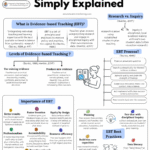Misleading examples are everywhere—hidden in motivational speeches, catchy social media quotes, and even well-meaning advice from friends. They often sound inspiring, promising that persistence and repeated effort will always lead to success. But the truth is, not all situations work that way, and blindly following such misleading examples can lead to false confidence, wasted time, or even dangerous mistakes. In this detailed guide on Simply Life Tips, we dive deep into the world of misleading examples, expose why they can be harmful, and share practical tips to help you recognise when an analogy is worth following and when it’s better to walk away.
Misleading Examples
In life, we often find comfort and motivation in examples of persistence and determination. Stories about falling before learning to walk, losing balance before mastering a bicycle, or swallowing water while learning to swim are deeply familiar and encouraging. They remind us that failure is part of the journey to success. However, not all examples carry a universal truth. Some analogies, while inspiring on the surface, can be misleading if applied without context. Knowing which lessons truly fit your situation can make the difference between progress and harm.
The Power and the Danger of Misleading Examples
Examples are powerful tools for learning. They simplify complex ideas, inspire confidence, and make abstract lessons easier to understand. When someone says, “You learn from falling,” it encourages resilience. But here’s the catch—if you apply the wrong example in the wrong situation, it can lead to false expectations, bad decisions, or even danger.
For instance, the idea of “keep trying until you succeed” works beautifully in learning musical instruments, sports, or academics. But in high-risk activities—like climbing tall trees, handling dangerous machinery, or driving without proper training—repeated trial and error can have severe consequences. The reality is simple: not all failures are recoverable, and not all risks are worth taking.
Popular Examples That Often Mislead

1. “You Have to Fall Before You Can Walk”
Every child indeed takes many tumbles before they finally walk. This is a harmless learning curve—falling on a soft floor or carpet rarely causes serious harm. The problem comes when people apply this example to situations where the stakes are higher.
Example:
A new entrepreneur may think, “I’ll just try without preparation; I’ll learn from my mistakes.” But in the business world, some mistakes—like poor financial planning or legal missteps—can be extremely costly and hard to recover from.
Lesson: Falling is fine when the environment is safe. But in high-risk ventures, preparation, research, and guidance are far more valuable than blind trial and error.
2. “Keep Losing Balance Until You Master the Bicycle”
Learning to ride a bike involves wobbles, small scrapes, and harmless falls. This is a safe analogy in the right setting. But if you replace the “bicycle” with something like managing company finances, the same approach becomes reckless.
Example:
A person handling investments without experience might think, “It’s okay if I lose money at first; I’ll get better over time.” However, losing significant amounts can damage credit, trust, and opportunities in ways that can’t easily be undone.
Lesson: Practice and persistence work well when mistakes are inexpensive. When mistakes carry big consequences, practice should happen in controlled, low-risk environments.
3. “You Have to Fail Before You Pass Your Driving Test”
Many people fail their driving test before passing—this is normal and often harmless. But applying this mindset to driving itself, outside of the learning phase, is dangerous.
Example:
Someone might think, “I’ll just drive and learn on the road without much training.” But here, mistakes could lead to accidents, injury, or even death—not just for the learner, but for others.
Lesson: Controlled failure during training is valuable, but in real-life execution, especially where lives are at stake, safety must come before trial and error.
4. “You Have to Swallow Water Before You Learn to Swim”
This analogy is harmless in the context of safe swimming lessons under supervision. But applied literally to risky situations—such as deep-sea diving without training—it becomes a fatal mistake.
Example:
Trying extreme sports without proper gear or training, thinking, “I’ll just figure it out,” can lead to irreversible consequences.
Lesson: Exposure to small, controlled risks is fine. But when the risk involves health, life, or irreversible damage, preparation and caution must come first.
5. The Tree-Climbing Truth
Here’s where these analogies break down completely: tree climbing.
You’ll never hear someone say, “I learned to climb trees by falling multiple times.” Why? Because falling from a tree often results in serious injury—or worse. There’s no gentle middle ground.
Lesson: The idea of “fall and get back up” doesn’t apply when the cost of falling is too high. Some challenges allow for failure as part of the process; others demand skill, guidance, and safety from the start.
Why Misleading Examples Can Be Harmful?
Blindly applying an example without considering the specific context can create serious obstacles to personal growth and decision-making. While examples are meant to guide and inspire, when taken out of context, they can lead to three significant problems.

1. False Confidence
One of the most common dangers of misleading examples is the false sense of security they create. Believing that persistence alone is enough to guarantee success can cause people to underestimate the complexity of a challenge. For instance, someone might think, “I succeeded in learning to play the guitar by practising every day despite my mistakes, so I can do the same with investing in the stock market.” While persistence is valuable, it’s not the only ingredient for success—strategy, preparation, and expert knowledge are equally important. Without them, you may end up making repeated errors without actually improving. In high-stakes environments, such as business, medicine, or safety-critical work, this misplaced confidence can cause severe consequences.
Real-Life Scenario:
A young entrepreneur starts a restaurant without market research, believing that his passion for cooking is enough to guarantee success. Within six months, poor location choice and lack of financial planning led to closure—something that persistence alone couldn’t fix.
2. Delayed Learning
Using the wrong analogy can send you down the wrong learning path, wasting valuable time and effort. If you believe that a situation can be solved by sheer repetition—because “that’s how I learned to ride a bicycle”—you might stick with ineffective methods far too long. For example, in a workplace setting, following outdated sales tactics simply because “they worked in another industry” could delay your ability to adapt to modern strategies. This not only stalls progress but can also make you miss opportunities that require quick adaptation. The longer you cling to the wrong lesson, the harder it becomes to correct course.
Real-Life Scenario:
A marketing executive continues to rely on cold-calling because it worked a decade ago, ignoring new trends like social media engagement. Competitors who adapt to modern methods quickly overtake the company’s market share, leaving it scrambling to catch up.
3. Unnecessary Risk
Perhaps the most dangerous consequence of applying misleading examples is the potential for unnecessary and avoidable risk. In situations involving health, finances, or physical safety, trial and error is not always a wise option. For instance, learning to drive by simply “figuring it out on the road” without proper instruction could lead to accidents that endanger lives. Similarly, attempting complex machinery repairs without training, because “I learned cooking by just experimenting,” could result in serious injury. The wrong example may encourage someone to take shortcuts or bypass safety measures, believing they will “learn along the way,” when in reality, the cost of failure could be permanent.
Real-Life Scenario:
A hobbyist tries to fix his home’s electrical wiring by watching a short video online, thinking it will be as easy as learning to bake bread through trial and error. A single wrong connection leads to an electric shock and an expensive repair bill that could have been avoided with professional help.
How to Identify Practical vs. Misleading Examples?
Recognizing whether an example is truly practical or dangerously misleading requires careful thought and analysis. While motivational analogies can be inspiring, applying them without scrutiny can lead to poor decisions. Here’s how to separate the useful lessons from those that may cause more harm than good.

1. Assess the Risk Level
Before adopting an example as guidance, evaluate the level of risk involved in your situation. Ask yourself: If I fail using this approach, what’s the worst that can happen? Some activities—like painting, cooking, or writing—allow for trial and error without severe consequences. However, others—such as working with electricity, driving in heavy traffic, or making large financial investments—carry high stakes where mistakes can cause irreversible damage. For instance, the idea of “keep trying until you get it right” works for learning chess but not for performing medical procedures. Always ensure the environment is safe enough before experimenting.
2. Check the Relevance
An example might sound inspiring, but it must also be relevant to your unique circumstances. If you’re forcing a comparison just because it sounds clever, chances are it’s not truly applicable. For example, learning to swim by practicing in shallow water under supervision is not the same as starting a business in a volatile market without a plan. The key is to ensure that the analogy matches the nature, challenges, and potential risks of your specific situation.
3. Understand the Learning Curve
Different skills have different learning curves. Some allow for harmless mistakes along the way, while others require precision from the very beginning. For example, a graphic designer can experiment with different layouts without causing harm, but an airline pilot must get it right from day one. Misjudging the learning curve can lead to frustration, wasted effort, or dangerous errors. When applying an example, be realistic about how much room there is for error in the skill you’re trying to master.
4. Look for Real-Life Evidence
Before trusting an example, check if there’s real-world proof that the same approach has worked for others in similar situations. Many motivational sayings sound powerful but lack actual evidence. For example, the phrase “fail fast, fail often” is common in startup culture, but it ignores the reality that not every business can recover from repeated failures—especially when resources are limited. Look for credible case studies, expert opinions, or first-hand success stories that support the example you’re considering.
5. Prioritise Safety and Preparation
When in doubt, always choose safety over blind persistence. Preparation, proper training, and expert advice can help you achieve your goals more effectively than diving in unprepared. This doesn’t mean avoiding all risks—it means managing them wisely. For example, before attempting mountain climbing, a well-prepared individual takes training courses, practices on smaller climbs, and gathers the right equipment. Blindly applying the “just start and you’ll figure it out” mindset in such a situation can lead to life-threatening consequences.
Choosing Safety Over High Risk – Why Smart Choices Protect Your Future
Embracing Realistic Positivity
Motivation is important, but it must be grounded in reality. Unrealistic positivity—believing that any failure can be overcome if you just try hard enough—can lead to disappointment or disaster. Instead:
- Seek inspiration from examples that truly fit your circumstances.
- Learn from mentors and experts who have succeeded in your field.
- Accept that some risks are not worth taking without adequate preparation.
- Understand that persistence works best when combined with strategy and caution.
Conclusion
Misleading examples often sneak into our thinking because they sound inspiring and familiar. But not every analogy fits every situation. The lesson is simple: context matters. Falling before walking works as a metaphor for safe, low-risk challenges, but it doesn’t apply to high-stakes situations where mistakes can be costly or dangerous.
Let go of impractical positivity and choose examples that truly help you move forward. Learn to separate motivational stories from realistic, applicable advice—and your path to success will be safer, smarter, and far more effective.
The next time you hear a motivational example, will you pause to check if it’s a practical lesson or a misleading example before applying it to your life?
FAQs on Misleading Examples
1. Why are some examples misleading in real life?
Because they are taken out of context and applied to situations where the risks, challenges, or consequences are completely different.
2. Can motivational quotes be harmful?
Yes, if they create false confidence or encourage risky behavior without proper preparation.
3. How can I tell if an example is relevant to my situation?
Check the level of risk, the similarity of circumstances, and whether the analogy has real-life proof in your field.
4. Are all failures valuable learning experiences?
Not necessarily—some failures carry irreversible consequences that outweigh the potential benefits of learning from them.
5. What’s the best way to stay motivated without falling for misleading analogies?
Combine motivation with realistic assessment, preparation, and guidance from credible sources.
Thank you for taking the time to explore this post. I hope you found it both insightful and enjoyable.
Remember, your sharing can make a positive impact! Please share this post across your social media and other networks, allowing others to benefit from its content.
PVM

Mathukutty P. V. is the founder of Simply Life Tips, a blogger, content writer, influencer, and YouTuber passionate about learning and sharing. Guided by “Simple Living, Creative Thinking,” he believes in the power of knowledge sharing and lifelong learning.
Related
Discover more from Simply Life Tips
Subscribe to get the latest posts sent to your email.







